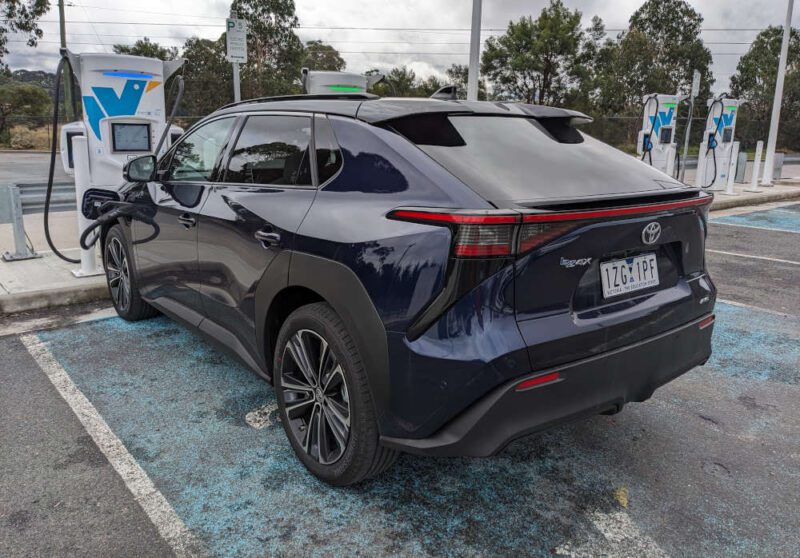Key points:
|
Table of contents
- EV driving experience
- Range and efficiency
- Charging
- EV integration with navigation
- Storage space
- Convenience features
- Servicing and warranty
- Conclusion
Toyota delivered their first bZ4X SUV overseas in the middle of 2022, but now Australian customers can finally get their hands on one. The Driven recently published a bZ4X road test which describes it as a solid vehicle with good driving dynamics and a spacious, comfortable cabin.
Toyota has been the largest car manufacturer in the world for many years now, so you would expect the bZ4X to feel like a reliable and well made car.
Given it is their first fully electric vehicle though, how well does it perform when you dive deeper into the EV specific aspects? And how does it stack up against its closest competitors, which include the top selling Tesla Model Y, Hyundai Ioniq 5, Kia EV6 and Ford Mustang Mach-E SUVs?
For this new review, I put a bZ4X AWD through a series of tests to understand how it compares against competing EVs when it comes to ease of driving, range and efficiency, charging, storage space and convenience.
EV driving experience
Like most electric vehicles from legacy automakers, the Toyota bZ4X is fitted with a power button that needs pressing to fire up the vehicle. Unless you have grown accustomed to an EV without a start/stop or power button, it might be hard to understand why this extra step can be a big deal.
An analogy for simplifications like removing the power button is when some background noise you’ve grown accustomed to finally stops, like a jackhammer or the hum of air-conditioning in an office. The peace and quiet experienced at that moment is an unexpected relief, and you feel surprised how much better it is without the noise.
A few times throughout the week I forgot to switch the bZ4X off and was standing outside trying to lock it. Instead of just beeping at me and refusing to lock, it would be nice if the car understood your intentions and simply switched off while locking.
Regenerative braking settings is another area where a handful of EVs such as Tesla, Polestar and the Ford Mustang Mach-E have got things right by remembering your preferences in between drives, making these cars quick and simple to jump in and drive.
Regenerative braking in the Toyota bZ4X is very weak by default. There is a button on the centre console to enable a stronger mode if desired, which needs to be pressed every time you start the car. At least it is a dedicated button next to the gear selector and not buried within touchscreen settings.
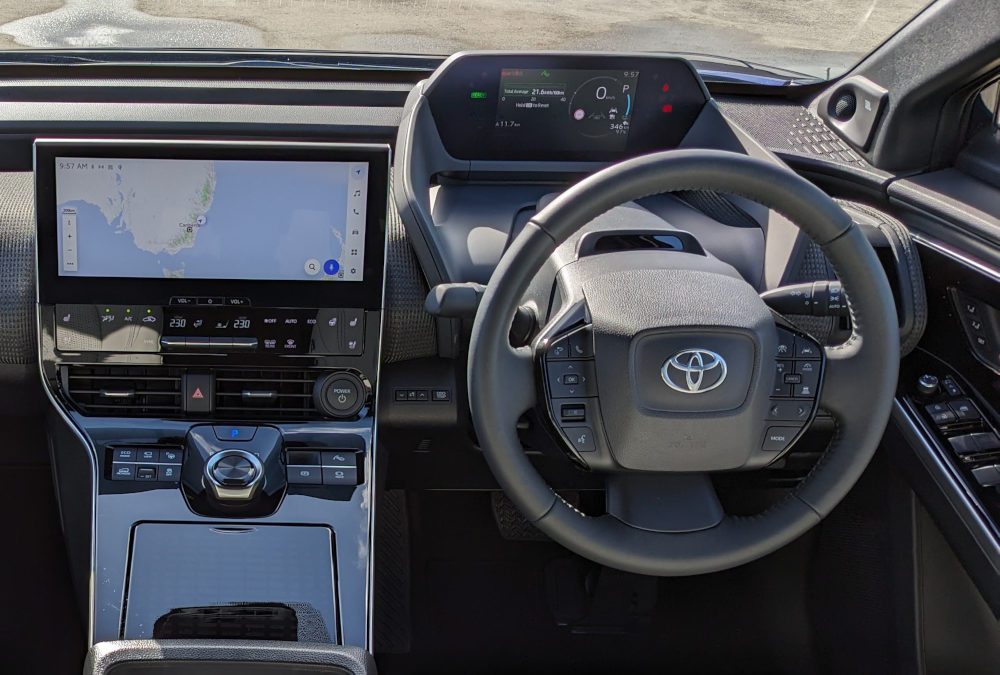
Even in the stronger setting, the bZ4X does not come to a full stop by itself and requires the brake pedal to stop rolling forwards. There is a separate hold mode which keeps the vehicle still if you want to take your feet off the brake pedal while resting at traffic lights, although it holds on tightly and occasionally causes jerky rather than smooth starts.
Similar to the power button analogy, well executed one pedal mode in an EV makes driving much easier and simpler. It is also safer if you need to stop quickly as the car begins to slow down as soon as you lift off the accelerator. Once you get used to driving mostly with one pedal, it can be jarring when you have to go back to using two pedals.
I understand legacy automakers wanting to make things easy for people making the switch from ICE cars, but it feels like a missed opportunity to not offer a one pedal driving mode that is at least configurable via vehicle settings. This way, new EV drivers can gradually adopt one pedal driving if they choose to.
Aside from my gripes above, the Toyota bZ4X feels smooth and powerful to drive like most EVs. The accelerator is responsive, with plenty of torque available at lower speeds. Power drops off noticeably at highway speeds though, and I imagine this would be more noticeable in the single motor front-wheel drive version which has less power and torque.
The bZ4X suspension handles various road surfaces and situations well, with the exception of larger bumps which can crash through the cabin. In general the bZ4X feels comfortable and corners reasonably well too. In terms of noise levels, I did notice more wind noise on the highway compared to other EVs as well as some road noise on rougher surfaces.
Range and efficiency
One of the key factors people consider when buying an EV is the range. Toyota advertises the bZ4X with a WLTP driving range of up to 436 km on the front-wheel drive version or 411 km on the all-wheel drive tested here. On a full charge the range on the dash showed 359 km with climate control switched on.
The 411 km WLTP driving range is already less than extended range variants of competing EVs which offer between 450 – 550 km under the same test conditions. One thing to keep in mind is Toyota has started conservatively with their battery management, limiting usable capacity to 64 kWh out of 71.4 kWh gross capacity, or in other words a buffer of around 10 %.
For comparison, Kia and Hyundai e-GMP vehicles with a 77 kWh gross battery have a usable capacity of 74 kWh. Percentage wise, this equates to a much smaller buffer of just under 4 %, meaning more of the battery is available for driving.
In the real world, my energy consumption in the Toyota bZ4X around town was 19.2 kWh / km which is on the high side but not terrible. Calculating maximum range using 64 kWh of available battery capacity results in a distance of 333 km if travelling on city or suburban roads.
To determine highway range I drove from Sydney towards Canberra, aiming to turn around and arrive at the Evie Sutton Forest charging station with roughly 10 % remaining. However, range dropped precipitously towards the end and I ended up arriving at the charger with 0 % and only 2 km remaining on the dash.
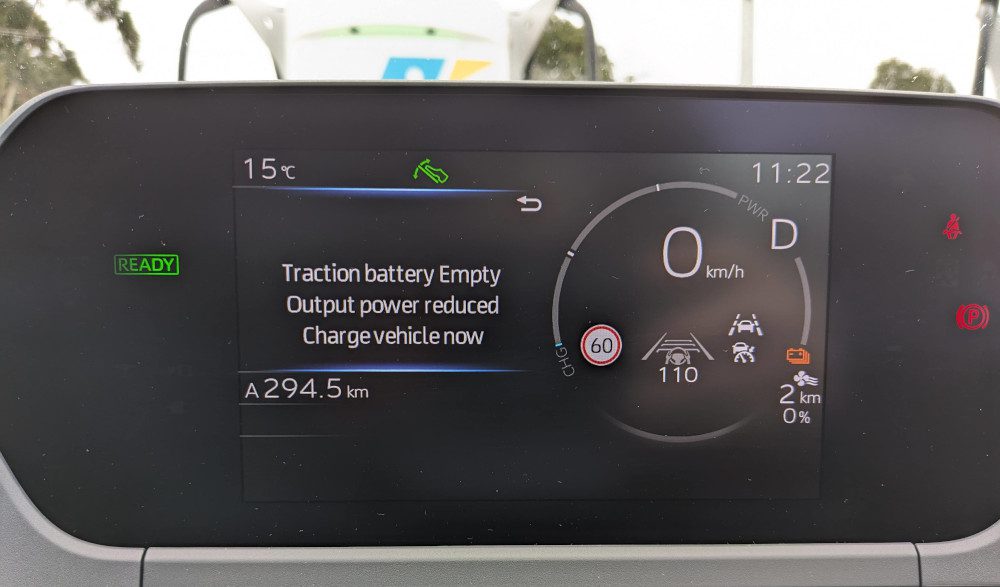
Overall efficiency on the highway loop averaged out to 19.6 kWh / 100 km, for a maximum range of 327 km if using the entire battery. Under more typical road trip conditions where you aim to keep the battery between 10 – 80 %, this would result in a highway range of 229 km (327 km * 0.7).
Charging
Maximum DC fast charging speed for the Toyota bZ4X is 150 kW, while Toyota advertises a 10 – 80 % charge in 40 minutes. The maximum speed I saw while charging at the 350 kW Evie station was only 133 kW, but this was enough to beat the advertised time, going from 0 – 80 % in just 38 minutes.
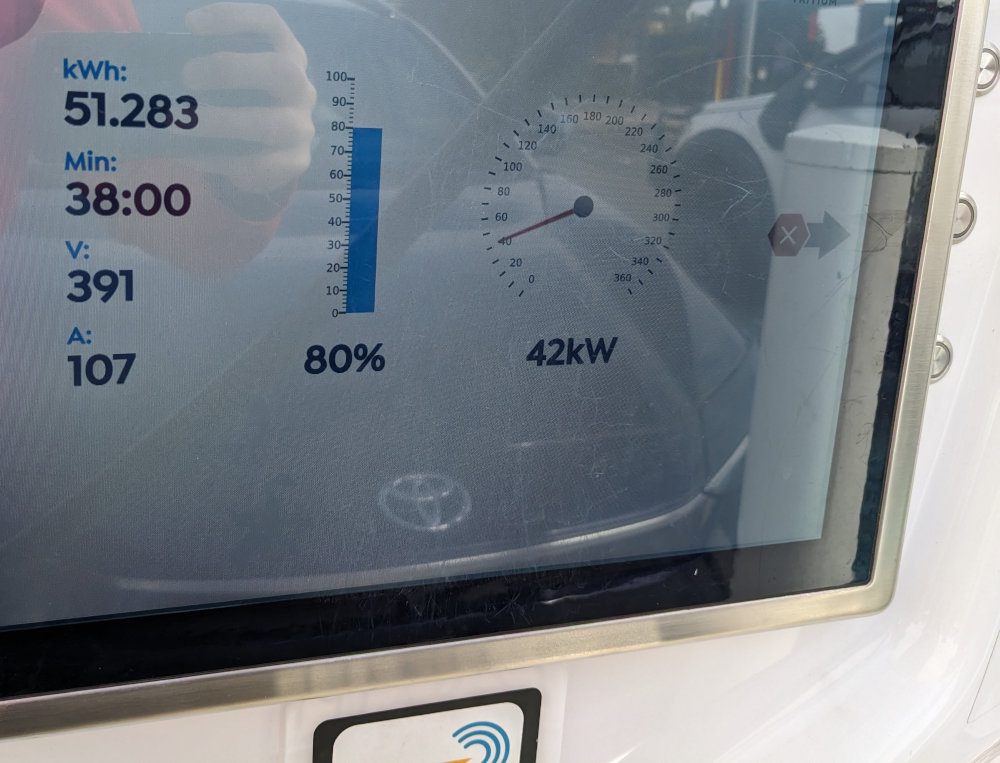
By the time I unplugged at 80 % state of charge, the bZ4X had slowed down to just over 40 kW, so a full charge to 100 % would take significantly longer. AC charging speed is up to 11 kW via a three phase connection or 7 kW with single phase, enough for a full charge in the range of 6 – 10 hours depending on the electricity supply.
Toyota provides both a portable EVSE for charging from standard power outlets as well as a type-2 to type-2 cable for BYO cable AC charging stations which saves people purchasing one themselves later.
While plugged in and charging, the bZ4X provides minimal information on the driver’s display, only showing the state of charge and time remaining to 80 % or full. There is no indication of the current charging speed or a button to stop the charging session for example, things that you would typically expect to see.
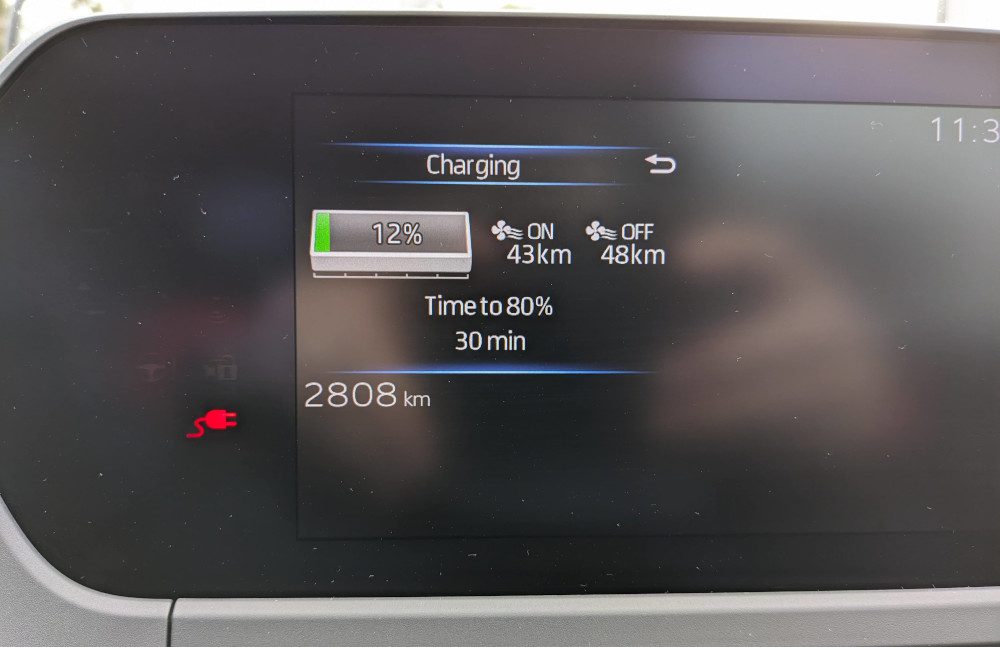
Vehicle charging settings allow adjustment of the maximum DC charging speed in 25 kW increments which is unusual, given you usually just want the fastest DC charge possible.
I also found the behaviour of the bZ4X charging port confusing while AC charging and it could potentially lead to situations where the car doesn’t charge as expected. For example, if you plug into an AC charger before locking the car it won’t start charging, even after the car is locked.
However, unlocking and then relocking the car with the cable plugged in begins charging. Locking and unlocking the car is also linked to the charge port, so unlocking the car while charging interrupts AC charging. Thankfully, this didn’t seem to happen while DC charging otherwise it would potentially require restarting the session through the relevant app.
EV integration with navigation
Toyota’s built-in navigation system has fairly limited integration with EV charging stations. If searching for a destination past the remaining range, the bZ4X offers a button to add a nearby charging stop but won’t automatically plan out a whole trip with multiple charging stops adequate distances apart.
My passenger during the highway range test could not find a way to search for charging stations while we were driving, although once we got down to a low state of charge the car suggested nearby stations. While stopped, the magic search term “charging station” brings up plenty of results from various charging networks.
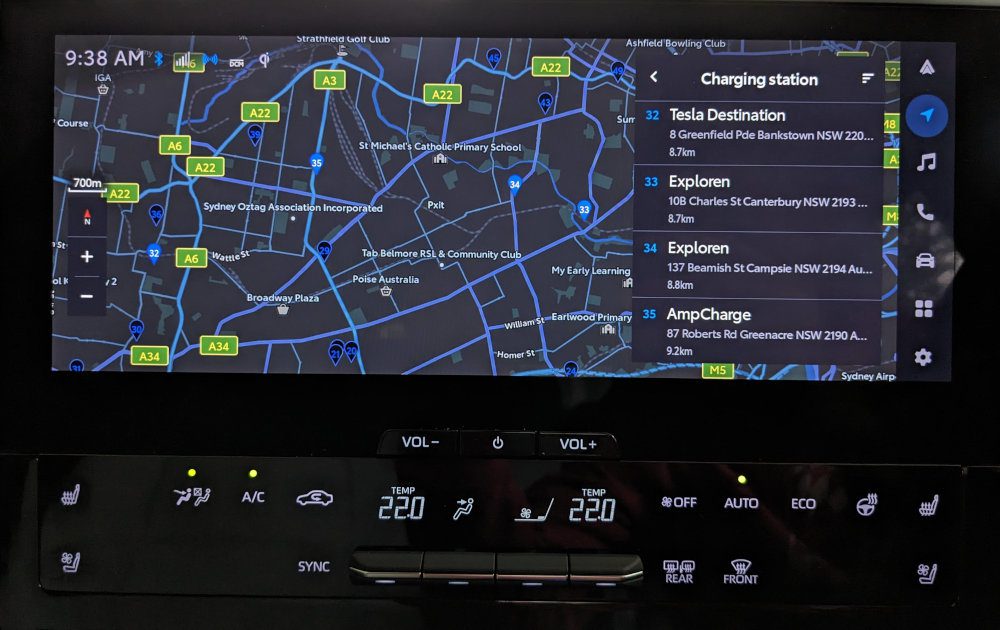
However, there is no information on the speed of each charging station, real time availability and so on. Phone mirroring via Android Auto or Apple CarPlay alleviates these issues though, so you can use your favourite apps on the car screen instead and forget about the built-in navigation.
Storage space
Exterior storage space in the Toyota bZ4X is limited to the boot as there is no front trunk (frunk), despite the car having a largish bonnet. Boot space is widely reported as 452 L in the front-wheel drive variant or 441 L in the all-wheel drive, although Toyota’s Australian specifications lists 421 L and 410 L respectively.
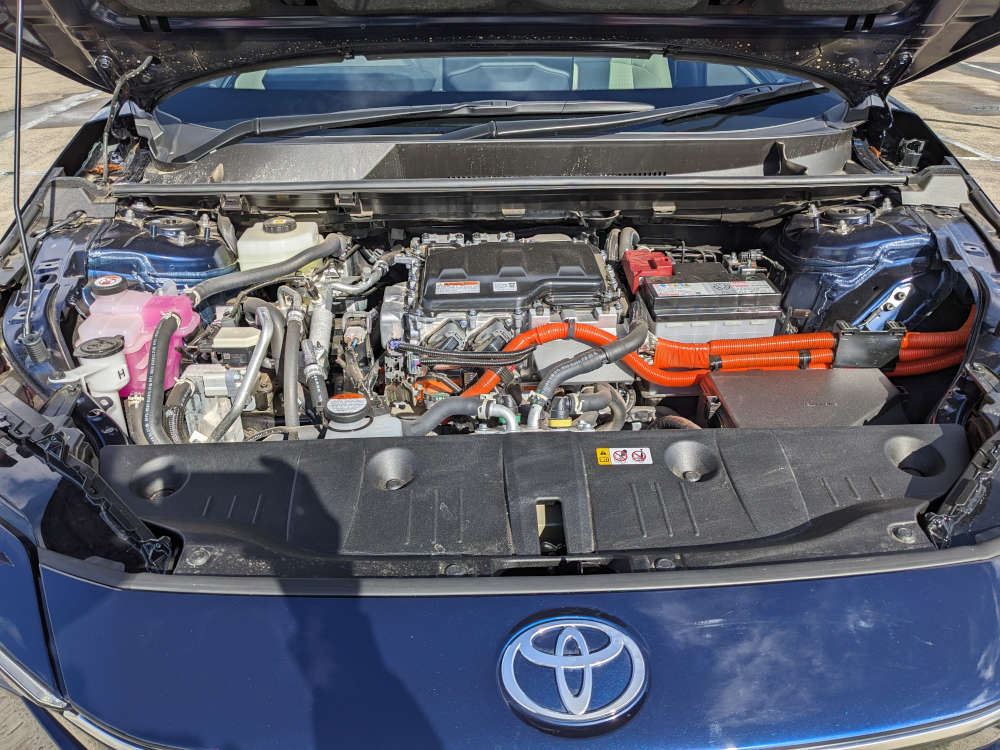
Either way, boot space in the bZ4X is smaller than most electric SUV rivals such as the Hyundai Ioniq 5 (up to 527 L), Kia EV6 (up to 490 L) and significantly less than the Tesla Model Y (854 L). The underfloor area in the boot is large enough for some charging cables although it didn’t fit the portable EVSE that came with the test car.
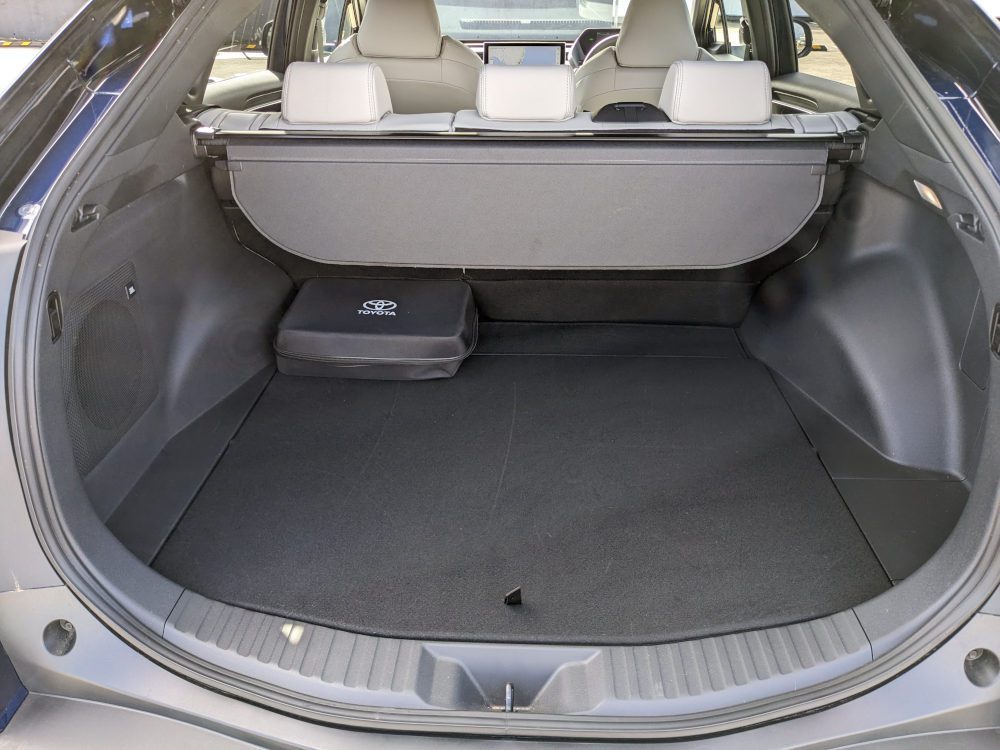
Interior storage space throughout the Toyota bZ4X is reasonable, with large door bins in all four doors, an enclosed compartment under the centre armrest and an open area between the two front seats underneath the cup holders and wireless charging compartment. There is no glove box though, so the car manual was stored in the centre console compartment.
Convenience features
One of the many advantages of electric vehicles are the convenience features that they offer such as vehicle to load (V2L) functionality and remote climate control. V2L is not present in the bZ4X though. The key fob has an A/C button which can be used to turn on the climate system to preheat or cool the car if you are close enough to the vehicle for the key to work.
If you are outside the range of the key fob, the myToyota Connect phone app can be used to remotely lock/unlock or start the car, enable climate control and monitor charging sessions. Toyota includes 1 year complimentary access before charging $9.95 per month for these features or $12.50 per month with additional connected profile and navigation features.
Servicing and warranty
Toyota bZ4X is covered by a 5 year unlimited km warranty, which can be extended to 7 years if you service the vehicle through Toyota according to the logbook. The battery pack is covered for the standard 8 years or 160,000 km, again provided regular health checks are performed by Toyota.
Interestingly, the warranty terms on Toyota’s hybrid vehicle batteries are better, offering up to 10 years and unlimited km with regular Toyota servicing. This seems counterintuitive given hybrid battery packs are smaller and will be cycled at a much higher rate than those found in battery electric vehicles.
Service intervals on the bZ4X are 12 months or 15,000 km. Capped price servicing is available for the first five years and costs $180 per service, cheaper than what Kia and Hyundai charge for their EVs. Service intervals are often longer than this for EVs, with several brands requiring a service every 2 years or 30,000 km.
Conclusion
Overall I found the Toyota bZ4X was a decent electric vehicle to drive, despite lacking a full one pedal drive mode. When compared to rival electric SUVs from brands like Kia, Hyundai and Tesla, the bZ4X falls short in terms of range, charging speeds, storage space and convenience features.
If Toyota wants to retain its title of the biggest automaker in the world as the EV transition continues, their subsequent EVs will need to be much better than their first offering. They could have more money available to develop competitive electric vehicles if they spent less on greenwashing and slowing down the EV transition.

Tim has 20 years experience in the IT industry including 14 years as a network engineer and site reliability engineer at Google Australia. He is an EV and renewable energy enthusiast who is most passionate about helping people understand and adopt these technologies.


